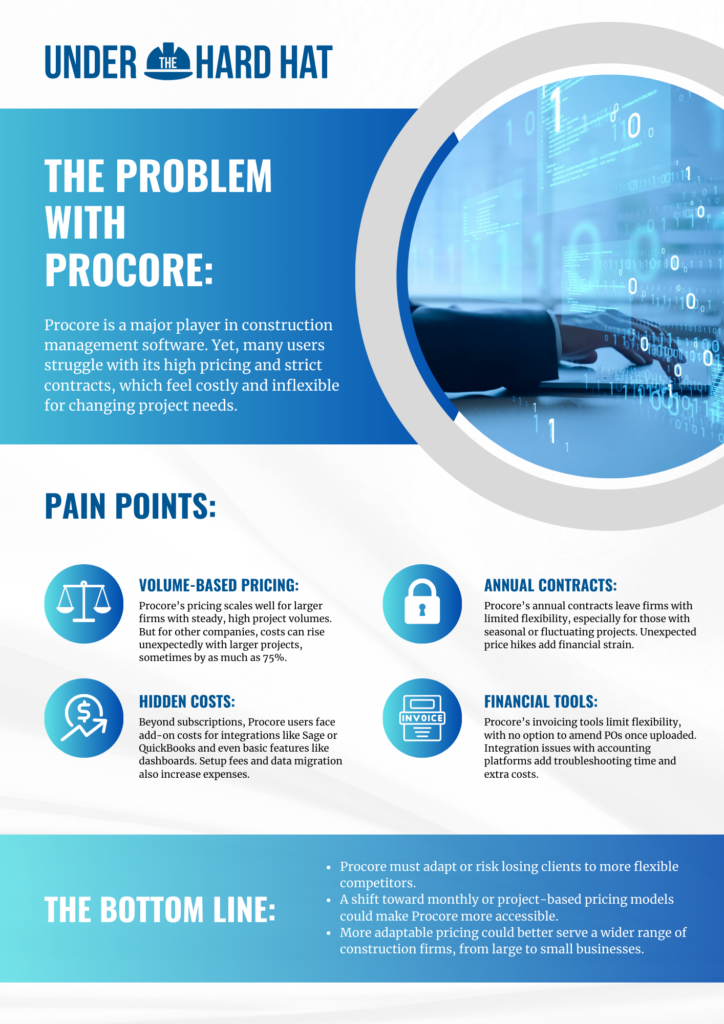With a $4B business firmly entrenched in a $10T industry, Procore is one of the biggest players in the construction management software market. It offers a robust platform integrating everything from project planning to document control. But while Procore’s comprehensive feature set makes it a powerful tool, its pricing model and shady subscription practices have left many firms frustrated by unexpected costs and restrictive contract terms.
Quick look
- Procore’s volume-based pricing links software fees to construction revenue, leading to high costs during strong revenue periods and creating financial unpredictability.
- Annual contracts limit flexibility, placing financial strain on companies with fluctuating project pipelines and reducing Procore’s appeal for firms seeking adaptability.
- Additional fees for setup, data migration, and integrations inflate costs, diminishing Procore’s value for smaller firms or those with tight budgets.
- Inflexible invoicing tools require manual corrections for budget changes, often causing delays when syncing with accounting software.

Volume-based pricing: An unwelcome guest in the deal
Procore’s volume-based pricing model is designed to scale with a company’s Annual Construction Volume (ACV), tying the cost of the software to the total value of a firm’s construction projects rather than using per-user or per-project fees. Theoretically, this model would be a natural fit for large construction firms with high project volumes.
However, the combination of Procore’s estimations of a client’s future revenue paired with the fluctuating nature of construction should give stakeholders pause as to whether this model is indeed scalable. “If I land a big job with more revenue in a given year, I have to write Procore a check,” says Jacob C*, owner of a top construction firm in the U.S. “But I lose my discounts if I drop below my anticipated revenue.”
In this light, Procore’s volume-based pricing can feel punitive rather than advantageous. “A colleague recently told me, ‘If I make more money, I have to pay Procore; they’re in my deal. Why is Procore in my deal?’” says Jacob.
Contracts, renewals, and the ‘hostage mentality’
One of the most frequent criticisms of Procore’s pricing model is the requirement for annual contracts, which leaves little room for flexibility. Unlike software solutions that offer monthly subscription options, Procore ties its clients into long-term agreements. Committing to a year-long contract can feel restrictive and risky for businesses in an industry known for fluctuating workloads and seasonal construction projects.
Moreover, Procore’s points of contact are constantly changing. “I appreciate that they have massive customer service turnover, particularly in sales,” says Rob J*, a contractor from a top-tier Canadian construction company. “But that also means we’re always dealing with someone new upon renewal who has no prior experience with our business. That’s hardly a bespoke solution.”
As contractors navigate the high risks of their work, they want a contech partner—a solution that will help their business, not hinder it. “The original agreement was that costs would only go up no more than 10%. It went up more than expected… Conversations on renewals changed once they went public, and it felt like a cold sale, not the same people I had dealt with before,” recalls Jacob. “They told me I would owe them $30K, and the consultant wouldn’t get off the script about what we owed, so I had to escalate to a supervisor.”
This annual commitment can quickly become a financial burden for firms or subcontractors who don’t maintain a consistent project pipeline, and the lack of flexibility is a particularly sore point for businesses. “Procore pricing has gone up 75%, and my revenue has not,” says Jacob, claiming that Procore will “shut you off” in 30 days if a payment isn’t remitted.
“Here’s the deal—no one can switch a project management system over to a new platform in less than 30 days,” says Rob. “It’s a real ‘take-it-or-leave-it’ approach to what’s supposed to be a human-centric technology solution. It feels like a hostage negotiation if you ask me.”
“They’re a profit center, not your partner,” says Mark M*, a contractor located in the States. “As labor and material costs escalate, so does the project management software. Since they assess their fees on revenue, you wind up paying more for the same project. No other enterprise software—not Microsoft, Google, or Oracle—are privy to your revenue for the purpose of assessing your software cost.”
Beyond the subscription: Hidden costs
Beyond Procore’s subscription fees, users face additional costs, from setup and data migration to paid add-ons for integrations. These extra charges quickly add up, and the resources required to maintain Procore’s system can feel overwhelming. “Being fully customizable will cost you more,” says Jacob. “We’re charged for each add-on, and while some of these features are optional, they drive up costs if we want the platform to work fully with our other tools. For example, the add-on to have dashboards is an extra cost, which was more surprising from an executive perspective than anything. You would assume it’s part of the base system. Who pays for Procore? The ownership of the company. The people at the top.”
These extra charges can be significant and sometimes overwhelming in a volatile industry. Implementation fees, for instance, often vary depending on the complexity of the project, the number of users, and the systems already in place. For businesses transitioning from simpler software or manual processes, this can involve substantial data migration costs. Moving all existing project data into Procore’s system is not always seamless and often requires additional resources or external support. “It’s a bad business practice to add features that are underdeveloped and not user-friendly, then making construction companies bear that cost,” says Rob. “Procore is not a partner for the long haul. We’re getting stuck with huge rate increases when nothing has been changed except the sales rep.”
Integrations with other software, such as accounting platforms or document management systems, also come at a price. While Procore offers a wide range of integrations—like Sage, QuickBooks, and DocuSign—these connections don’t always function as smoothly as advertised, requiring further customization or troubleshooting, which adds both time and cost.
For businesses already dealing with tight budgets, these hidden costs diminish the platform’s overall value and make it hard to see a return on investment, especially when other software offers similar features at a fraction of the price.
Invoicing and financial tools: A rigid approach
Procore’s financial tools have also sparked frustration among users who need flexibility in their invoicing. Once uploaded, invoices and purchase orders (POs) cannot be amended, leading to time-consuming manual corrections when project costs change. This rigidity can create serious inefficiencies for construction firms that rely on agility and adaptability. Projects often evolve, requiring revisions to budgets or costs, but once the invoice is locked in Procore, users face the tedious task of correcting these issues manually. This process can delay payments and add unnecessary steps to what should be a streamlined system. “It’s not always easy to access critical information—sometimes, I just ask a power user to get the reports I need because navigating Procore’s system can be cumbersome,” says Mark.
In addition to these challenges, integration issues with accounting software like Sage compound the problem. Many users have reported discrepancies between Procore and their accounting platforms, which leads to additional manual corrections. While Procore does integrate with popular software like Sage, QuickBooks, and others, these connections don’t always function smoothly. When invoices don’t sync properly, users must spend extra time troubleshooting and reconciling errors. These inefficiencies can quickly add up, making the financial management process more complicated than it needs to be.
Market perception: A mixed bag
Procore has earned a reputation as a premium, all-in-one platform in the construction management software space. For large construction firms, Procore’s comprehensive feature set, including project management, financial tracking, and real-time collaboration tools, positions it as a powerful solution for streamlining complex operations. Many companies view Procore as an essential investment, appreciating how it integrates different aspects of construction management into one cohesive system.
However, Procore’s extensive capabilities appeal mainly to larger enterprises that can leverage its full potential. The market perception shifts dramatically when it comes to smaller businesses and niche industries. Unexpected costs and rigid policies have led many smaller firms to consider the software overly complex and pricey. Many companies believe that Procore’s commitment to annual contracts and volume-based pricing limits flexibility for fluctuating workloads, driving them toward more flexible alternatives.
The bottom line
Procore’s comprehensive toolset has positioned it as a leader in construction management software, delivering real benefits to firms able to leverage its full capabilities. However, the rigid volume-based pricing and costly add-ons can make it difficult to justify the investment. If Procore hopes to remain accessible to businesses of all sizes, there is a clear call to action for the company to reconsider its pricing approach. “Procore is a powerful tool, but if they don’t make changes, contractors may start seeking alternatives,” says Jacob. “There’s always a bigger, better mousetrap.” Until then, many companies will likely consider more budget-friendly, user-centric alternatives.
Like this article? Subscribe to our weekly newsletter for more like this.




1 comment